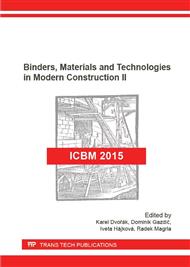[1]
V. E. Manevich, K. Yu. Subbotin, Foam glass and problems of energy conservation, In: Glass and Ceramics, (2008), Vol. 65 Issue 3/4, pp.105-108. 4p. 5 Charts, DOI: 10. 1007/s10717-008-9026-1.
DOI: 10.1007/s10717-008-9026-1
Google Scholar
[2]
Yu. A. Spiridonov, L. A. Orlova, Problems of Foam Glass Production, In: Glass and Ceramics, (2003), Volume 60, Issue 9, pp.313-314, DOI: 10. 1023/B: GLAC. 0000008234. 79970. 2c.
DOI: 10.1023/b:glac.0000008234.79970.2c
Google Scholar
[3]
A. S. Apkar'yan, V. G. Khristyukov, G. V. Smirnov, Granulated foam glass ceramic — a promising heat-insulating material, In: Glass and Ceramics, (2008), Volume 65, Issue 3, pp.74-76, DOI: 10. 1007/s10717-008-9018-1.
DOI: 10.1007/s10717-008-9018-1
Google Scholar
[4]
EN 1015-11 Methods of test for mortar for masonry - Part 11: Determination of flexural and compressive strength of hardened mortar.
DOI: 10.3403/01905442
Google Scholar
[5]
EN 12667 Thermal performance of building materials and products - Determination of thermal resistance by means of guarded hot plate and heat flow meter methods - Products of high and medium thermal resistance.
DOI: 10.3403/02109602
Google Scholar
[6]
ISO 8301 Thermal insulation - Determination of steady-state thermal resistance and related properties - Heat flow meter apparatus.
Google Scholar
[7]
ISO 10534-1 Acoustics - Determination of sound absorption coefficient and impedance in impedance tubes - Part 1: Method using standing wave ratio.
DOI: 10.3403/02406050
Google Scholar
[8]
Dan-Ting Yue, Zhi-Cheng Tan, You-Ying Di, Xin-Rong Lv and Li-Xian Sun, Specific Heat Capacity and Thermal Conductivity of Foam Glass (Type 150P) at Temperatures from 80 to 400 K1, In: International Journal of Thermophysics, Vol. 27, No. 1, (2006).
DOI: 10.1007/s10765-006-0026-5
Google Scholar
[9]
G. Bumanis, D. Bajare, J. Locs, A. Korjakins, Alkali-silica reactivity of foam glass granules in structure of lightweight concrete, In: Construction and Building Materials 47 (2013), p.274–281.
DOI: 10.1016/j.conbuildmat.2013.05.049
Google Scholar
[10]
L. Svoboda and col., Building materials, Jaga group, s. r. o., Bratislava (2007), ISBN 978-80-8076-057-1.
Google Scholar


